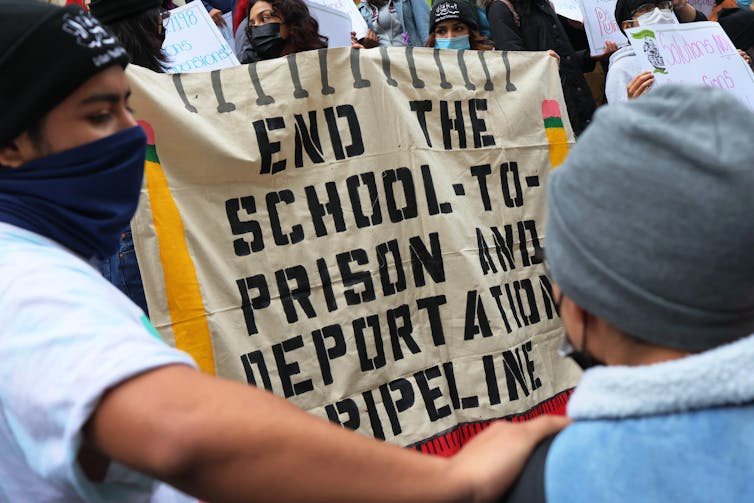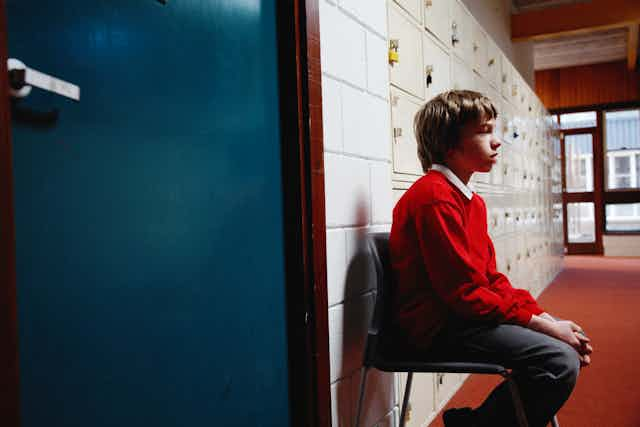The 2022-23 school year was a particularly violent year for educators.
In Florida, a high school student beat a paraprofessional unconscious. A 15-year-old in Georgia left her teacher with difficulty walking. And a group of students in Texas sent their assistant principal to the hospital after an assault.
Recent headlines suggest the 2023-24 school year may not be much different.
Such violence at school disrupts teaching and learning and has elicited calls to reform school discipline policies.
As a policy researcher who studies school safety and discipline, I have seen two camps form with polarized and politicized views on school discipline. On the one side are those who seek more restorative responses to misconduct that emphasize building relationships with students and discipline policies that keep kids in school. On the other are calls for greater use of exclusionary and punitive practices like suspension.
In my view, making schools safe requires school leaders not to get caught up in this either/or debate. Instead, I believe it requires recognizing a shared goal of safe schools and the need for a comprehensive approach to achieving it.
Behavior and the pandemic
Recent reports suggest these high-profile incidents of violence in schools are part of a general increase in student misconduct over the past couple of years. This contrasts with a decline over the prior decades.
For example, the National Center for Education Statistics found that 84% of public school leaders felt the pandemic negatively affected student behavior. Another survey found two out of three teachers and leaders perceived more student misbehavior in 2021 than in 2019.
Studies have shown that students who feel unsafe going to school have worse attendance rates than those attending schools with less violence and misbehavior. They also score lower on standardized tests, particularly when classroom instruction is disrupted.
What’s more, teachers who experience threats or physical violence from students are more likely to leave their positions, according to a study I co-authored in 2017.

Restorative justice experiences backlash
Over the past couple of decades, states and school districts nationwide have adopted school discipline reforms that prioritize relationships between peers and with teachers, positive incentives for good behavior and prevention of misconduct.
These policies, often implemented as part of restorative justice initiatives, focus on building community and a positive school climate instead of removing kids from school.
But as school violence persists, these restorative justice reforms are being called into question.
In Nevada, teachers union representatives from the Clark County Education Association sought to revise laws to immediately remove students for violence against school staff. The state legislature there passed legislation scaling back restorative justice and making it easier to suspend students. In San Diego, the superintendent promised to revisit restorative discipline policies after parent complaints about student safety. Policy advocates have claimed discipline reform has contributed to school shootings.
While restorative practices and other positive interventions can improve student outcomes, prior research has found many of these less punitive disciplinary reforms to be poorly implemented or less effective than hoped.
In some cases, this has meant students have been allowed to stay in school despite posing a threat to the safety of others.
Suspensions and expulsions aren’t the solution
The limitations of restorative practices have resulted in calls for a return to greater use of suspensions and other punitive discipline. In one of the most high-profile displays, a Florida sheriff announced in front of a jail plans for a return to more punitive discipline, suggesting a need for more use of detentions and suspensions. He lamented that students were no longer afraid of suspensions or having “the cheeks of their a– torn off for not doing right in class.”
In some cases, removing students who are disruptive to the classroom has had positive effects on other students’ achievement. But exclusionary school discipline like suspension and expulsion can have their own unintended consequences on students. For example, suspensions are related to lower academic test scores for those suspended as well as increased delinquency, such as criminal activity and arrest.
Additionally, schools suspend a disproportionately high number of kids who aren’t white – particularly Black students. In addition, males and students with disabilities are more likely to be suspended.
Ultimately, there is little evidence that suspensions and expulsions improve behavior. In fact, a recent national survey found that only 13% of principals agreed that suspensions reduce future misbehavior.
A path forward
Proponents of progressive discipline reform and those advocating for “get-tough,” exclusionary policies share a desire for safe schools. The sheriff speaking in front of the jail as well as his critics both want to prevent kids from ending up incarcerated.
How do policymakers and educators see past these divides to achieve safer schools?
First, it may help to acknowledge that effective school discipline policies can include both restorative and exclusionary practices. It is true that there is a need to reduce the disproportionate use of suspension for minor offenses. But it is also true that students who pose an immediate danger to others may need to be temporarily removed to settings where they can receive additional support.
Next, schools can focus on strengthening their school climate through excellent instruction and positive relationships between students and teachers. Welcoming schools where students are engaged in learning may preempt many behavioral situations.
Finally, policymakers can recognize that school safety is affected by the experiences of students outside of school. Addressing the trauma, violence and social disruptions experienced in homes and neighborhoods through broader public policy holds potential to improve safety inside schools.
All of this takes resources and support for schools, educators and students. I believe these are resources well spent, though, to achieve the shared goal of school safety.

